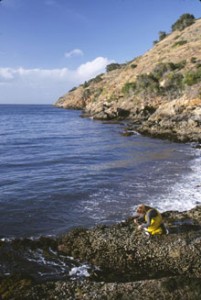
 REU Research foci: We (Partnership for Interdisciplinary Studies of Coastal Oceans or PISCO) have collated biodiversity surveys that date back to 1999 at over 100 sites from Mexico to Alaska that map the precise location of each individual along with its tidal height. These give comprehensive biodiversity assessments that can be geospatially depicted. We have also surveyed the ecological community at over 100 sites between Canada and Mexico. Some sites have been sampled since 1980, but most since 1999. We have targeted focal assemblages (e.g. mussels, flucoid algae) along with number and size structure of target species (e.g. abalone, seastars, Lottia, a giant limpet).
REU Research foci: We (Partnership for Interdisciplinary Studies of Coastal Oceans or PISCO) have collated biodiversity surveys that date back to 1999 at over 100 sites from Mexico to Alaska that map the precise location of each individual along with its tidal height. These give comprehensive biodiversity assessments that can be geospatially depicted. We have also surveyed the ecological community at over 100 sites between Canada and Mexico. Some sites have been sampled since 1980, but most since 1999. We have targeted focal assemblages (e.g. mussels, flucoid algae) along with number and size structure of target species (e.g. abalone, seastars, Lottia, a giant limpet).
Typical REU project: Select a species from the database (e.g. the seastar, Pisaster, and their preferred prey, mussels). Visit sites to sample this assemblage along the CA coast and analyze the interaction strength along part of the West Coast transect with path coefficient analysis (standard multiple regression technique used to assess ecosystem interactions). Determine whether interactions for these two ecosystems states vary in a consistent way from north to south ranges and if these are associated with physical oceanographic metrics such as sea surface temperature (SST). Question to pose: Are the changes in the ecosystem interaction strengths, which are correlated to sea surface temperatures (SST) of the north-south coastal transect similar to the changes in interaction strengths over time at specific sites, where sea surface temperatures have changed due to climate processes? If so future projections could be made regarding the impact of climate change on ecosystem interactions and along the species distributions; this might make it possible to predict spread or contraction of seastar dominated ecosystem states, and associated changes in mussels.
Contact Information:
Email: raimondi@ucsc.edu and mhcarr@ucsc.edu
Website: PISCO Research Lab

